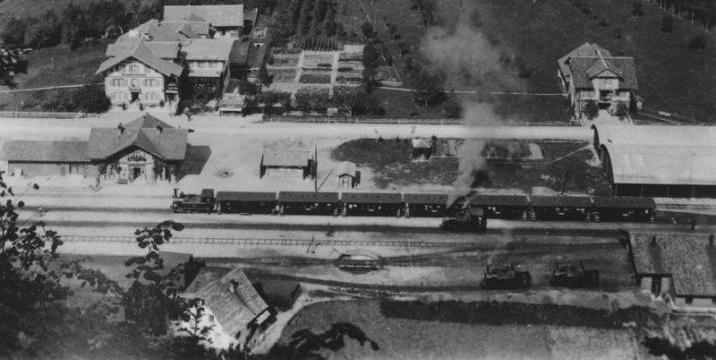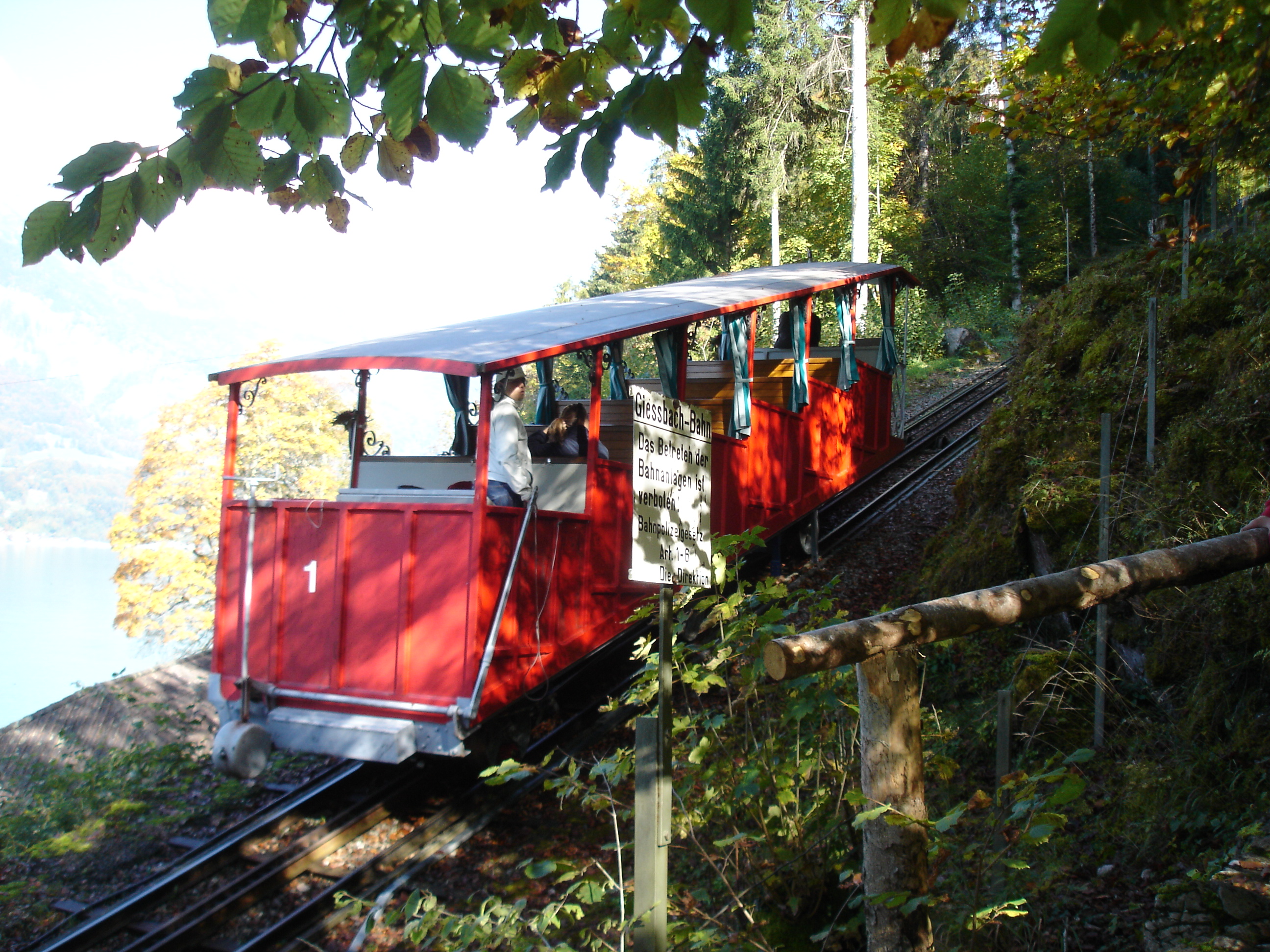|
Brienz Railway Station
Brienz railway station is a railway station in the village of Brienz in the Swiss canton of Bern. Brienz is a stop on the Brünig line, owned by the Zentralbahn, that operates between Interlaken and Lucerne. It is located across the street from Brienz BRB railway station, the lower terminus of the Brienz–Rothorn rack railway (BRB) that climbs to the summit of the Brienzer Rothorn mountain. The station provides an interchange with the local bus network provided by PostBus Switzerland. Shipping services operated by the BLS AG on Lake Brienz call at a quay adjacent to the station, linking to various lakeside places between Brienz and Interlaken. Amongst other destinations, buses link to the Ballenberg open-air museum, whilst boats link to the lower station of the Giessbach Funicular, which gives access to the Giessbach Falls. The station was opened in 1888 by the Jura–Bern–Lucerne Railway, as the western terminus of the Brünig line, with journeys to and from Interlaken r ... [...More Info...] [...Related Items...] OR: [Wikipedia] [Google] [Baidu] |
Brienz
Brienz ( , , ) is a village and municipality on the northern shore of Lake Brienz, at the foot of the Brienzer Rothorn mountain, and in the Bernese Oberland region of Switzerland. Besides the village of Brienz, the municipality includes the settlements of Kienholz and Axalp. Politically, the municipality is located in the Interlaken-Oberhasli administrative district of the canton of Bern. History The first settlements date from the neolithic and Bronze Ages. In the 5th century BC, the Celts settled in the alpine valleys among the sources of the Rhone, the Rhine and the Danube, eventually stretching from the headwaters down to Vienna and Belgrade. At the end of 1st century BC the Romans conquered this area. The Roman settlements were destroyed by the Alamanni in 259/60. They eventually settled in the area around 450. In any case, evidence has been found for a settlement by the Alamanni in the 7th century. Brienz is first mentioned in 1146 as ''Briens''. In 1528, a ... [...More Info...] [...Related Items...] OR: [Wikipedia] [Google] [Baidu] |
Ballenberg Open-air Museum
Ballenberg is an open-air museum in Switzerland that displays traditional buildings and architecture from all over the country. Located near Brienz in the municipality of Hofstetten bei Brienz, Canton of Bern, Ballenberg has over 100 original buildings that have been transported from their original sites. It is a Swiss heritage site of national significance. In addition to the main attraction of the buildings themselves, some of the industrial and crafting buildings still operate to give demonstrations of traditional rural crafts, techniques and cheesemaking. There is also a sizable number of farmyard animals in the grounds. Founded in 1978, the museum features buildings from all over the country and has structures from almost all of the cantons. The buildings are set in surroundings appropriate to their type (farm buildings surrounded by small fields etc.) with pathways snaking across the 660,000 square metres (164 acre) site. Most buildings allow the visitor to walk around the ... [...More Info...] [...Related Items...] OR: [Wikipedia] [Google] [Baidu] |
Railway Stations In Switzerland Opened In 1888
Rail transport (also known as train transport) is a means of transport that transfers passengers and goods on wheeled vehicles running on rails, which are incorporated in tracks. In contrast to road transport, where the vehicles run on a prepared flat surface, rail vehicles (rolling stock) are directionally guided by the tracks on which they run. Tracks usually consist of steel rails, installed on sleepers (ties) set in ballast, on which the rolling stock, usually fitted with metal wheels, moves. Other variations are also possible, such as "slab track", in which the rails are fastened to a concrete foundation resting on a prepared subsurface. Rolling stock in a rail transport system generally encounters lower frictional resistance than rubber-tyred road vehicles, so passenger and freight cars (carriages and wagons) can be coupled into longer trains. The operation is carried out by a railway company, providing transport between train stations or freight customer faciliti ... [...More Info...] [...Related Items...] OR: [Wikipedia] [Google] [Baidu] |
Regio (Swiss Railway Train)
Regional rail, also known as local trains and stopping trains, are passenger rail services that operate between towns and cities. These trains operate with more stops over shorter distances than inter-city rail, but fewer stops and faster service than commuter rail. Regional rail services operate beyond the limits of urban areas, and either connect similarly-sized smaller cities and towns, or cities and surrounding towns, outside or at the outer rim of a suburban belt. Regional rail normally operates with an even service load throughout the day, although slightly increased services may be provided during rush-hour. The service is less oriented around bringing commuters to the urban centers, although this may generate part of the traffic on some systems. Other regional rail services operate between two large urban areas but make many intermediate stops. In North America, "regional rail" is not recognized as a service classification between "commuter rail" and "inter-city rai ... [...More Info...] [...Related Items...] OR: [Wikipedia] [Google] [Baidu] |
Level Crossing
A level crossing is an intersection where a railway line crosses a road, path, or (in rare situations) airport runway, at the same level, as opposed to the railway line crossing over or under using an overpass An overpass (called an overbridge or flyover in the United Kingdom and some other Commonwealth countries) is a bridge, road, railway or similar structure that crosses over another road or railway. An ''overpass'' and ''underpass'' together form ... or tunnel. The term also applies when a light rail line with separate right-of-way or reserved track crosses a road in the same fashion. Other names include railway level crossing, railway crossing (chiefly international), grade crossing or railroad crossing (chiefly American), road through railroad, criss-cross, train crossing, and RXR (abbreviated). There are more than 100,000 level crossings in Europe and more than 200,000 in North America. History The history of level crossings depends on the locatio ... [...More Info...] [...Related Items...] OR: [Wikipedia] [Google] [Baidu] |
Swiss Federal Railway
Swiss Federal Railways (german: link=no, Schweizerische Bundesbahnen, ''SBB''; french: link=no, Chemins de fer fédéraux suisses, ''CFF''; it, Ferrovie federali svizzere, ''FFS'') is the national railway company of Switzerland. It is usually referred to by the initials of its German, French, and Italian names, either as SBB CFF FFS, or used separately. The Romansh version of its name, ''Viafiers federalas svizras'', is not officially used. The official English abbreviation is "SBB", instead of the English acronym such as "SFR", which stands for ''Swiss Federal Railways'' itself. The company, founded in 1902, is headquartered in Bern. It used to be a government institution, but since 1999 it has been a special stock corporation whose shares are held by the Swiss Confederation and the Swiss cantons. It is currently the largest rail and transport company of Switzerland, and operates on most standard gauge lines of the Swiss network. It also heavily collaborates wit ... [...More Info...] [...Related Items...] OR: [Wikipedia] [Google] [Baidu] |
Steam Locomotive
A steam locomotive is a locomotive that provides the force to move itself and other vehicles by means of the expansion of steam. It is fuelled by burning combustible material (usually coal, oil or, rarely, wood) to heat water in the locomotive's boiler to the point where it becomes gaseous and its volume increases 1,700 times. Functionally, it is a steam engine on wheels. In most locomotives, the steam is admitted alternately to each end of its cylinders, in which pistons are mechanically connected to the locomotive's main wheels. Fuel and water supplies are usually carried with the locomotive, either on the locomotive itself or in a tender coupled to it. Variations in this general design include electrically-powered boilers, turbines in place of pistons, and using steam generated externally. Steam locomotives were first developed in the United Kingdom during the early 19th century and used for railway transport until the middle of the 20th century. Richard Trevithi ... [...More Info...] [...Related Items...] OR: [Wikipedia] [Google] [Baidu] |
Interlaken Ost Railway Station
Interlaken Ost or Interlaken East is a railway station in the resort town of Interlaken in the Swiss canton of Bern. The station was previously known as Interlaken Zollhaus. The town has one other station, Interlaken West. Interlaken Ost is an important railway junction at the meeting point of three railway lines, the Thunersee line of the BLS AG, the Brünig line of the Zentralbahn, and the Bernese Oberland railway (BOB). In addition to trains operated directly by the owners of these lines, the station is also reached by passenger trains of the Swiss Federal Railways, Deutsche Bahn, all of which operate over the Thunersee line. The station provides an interchange with the local bus network provided by PostBus Switzerland and the regional bus line to Thun provided by Verkehrsbetriebe STI. Ships of the BLS-owned fleet on Lake Brienz serve a quay at Interlaken Ost, which they access via a navigable reach of the Aar river. History In 1872, the standard gauge Bödelibahn ... [...More Info...] [...Related Items...] OR: [Wikipedia] [Google] [Baidu] |
Jura–Bern–Lucerne Railway
The Bernese Jura Railway (''Chemins de fer du Jura bernois'', abbreviated ''Jura bernois'', JB) was a railway company in Switzerland. The company was called the Jura–Bern–Luzern (''Jura–Bern–Lucerne'', JBL) from 1 July 1884. The Jura–Bern–Lucerne merged with the Western Switzerland–Simplon Railways (''Suisse-Occidentale–Simplon'', SOS) to form the Jura–Simplon Railway (''Jura-Simplon-Bahn''), JS) on 1 January 1890. History The railway network of the Canton of Bern initially developed according to the interests of the Swiss Central Railway (''Schweizerische Centralbahn'', SCB). The Grand Council of Bern, decided to conclude a contract with the SCB in 1852. The Central Railway undertook to build the Murgenthal–Bern line and the Solothurn–Herzogenbuchsee railway within four years and in return received tax exemption and the privilege of being given preferential treatment in future grants of concessions to build railways. The Central Railway’s construct ... [...More Info...] [...Related Items...] OR: [Wikipedia] [Google] [Baidu] |
Giessbach Funicular
The Giessbach Funicular (german: Giessbachbahn) is a historic funicular in the Swiss canton of Bern and municipality of Brienz. It links a landing stage on Lake Brienz, served by shipping services on the lake, to the Grand Hotel Giessbach and Giessbach Falls above. The funicular is owned by the hotel, but since 1983 has been operated by a preservation foundation. Description The Giessbach funicular was designed by the Swiss engineer Carl Roman Abt. When it was opened in 1879, it was the first funicular with a two-rail single track layout with a relatively short passing loop in the middle. Its turnouts had no moving parts, which was quite a remarkable achievement for the time. Abt had later developed its modification which became known as the ''Abt Switch''. Originally the funicular was powered by water ballast, and the Riggenbach rack rail in the middle of the track was used for speed control. In 1912 the water ballast system was replaced by a hydraulic engine powered by a Pe ... [...More Info...] [...Related Items...] OR: [Wikipedia] [Google] [Baidu] |





